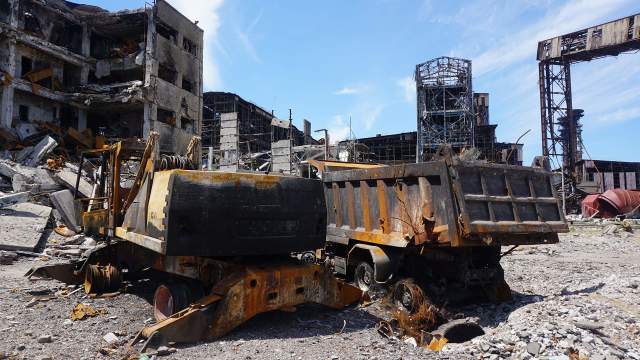The correspondent of Izvestia investigated the catacombs of the combine, in which Ukrainian formations were hiding
On the territory of the Azovstal plant there is almost everything — its own railways, bridges, and even "mountains" — embankments of mining and slag. Nearby is a residential neighborhood for employees and employees of the enterprise, a cozy stadium on the seashore. Heavy fighting unfolded around this plant in April and May. Allied troops were able to block Ukrainian armed formations here and force them to surrender. Military observer of Izvestia Alexey Ramm was one of the first not only to visit the territory of Azovstal, but also went down to the bunkers where the militants were hiding.
Along the routes of the assault groups
— Here were the Ukrainian positions. We knocked them out and went on," the commander of the company of the battalion of the operational purpose of the internal troops of the Donetsk Republic tells us.
We are walking through the territory of the Azovstal plant, along the route that Russian and Donetsk assault groups entered the territory of the enterprise. Explosions are constantly sounding not far from us. This is the work of sappers, eliminating unexploded ammunition and booby traps left over from the fighting. Some explosions sound like light pops, but there are also those that shake the ground, and the body feels the shock of the blast wave.
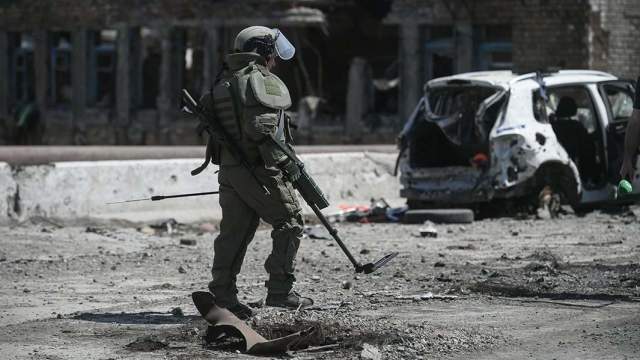
The sapper of the International Mine Action Center of the Armed Forces of the Russian Federation bypasses the territory of the Azovstal Metallurgical Plant in Mariupol for the purpose of mine clearance
Image source: Photo: RIA Novosti/Konstantin Mikhalchevsky
We climb to the bridge where the Ukrainian armed formations surrendered to the allied forces. Here they checked their documents and belongings, after which they conducted a brief survey and sent them to the buses. Ruins and underground bunkers are waiting for us ahead. It was there that the Ukrainian National guardsmen, fighters of the Azov regiment (criminal cases have been initiated against the group in the Russian Federation, — Izvestia), marines and fighters of other units who were blocked at the plant were hiding.
Battles at the Azovstal plant will definitely be included in all textbooks on tactics and operational art. For the first time in the world military history, clashes took place on the territory of such a complex technogenic object. And these were not just fights — we are talking about a complex interspecies operation. It was attended by ground units and subunits, the navy, aviation, special forces units and even law enforcement forces.
The Azovstal Metallurgical Plant is located in the southern part of Mariupol. The company occupies a small peninsula, which is separated from the city by the Kalmius River. There are several bridges across the river, one of them connects the plant with the port of Mariupol. In fact, he turned the factory and the harbor into a single agglomeration.
Next to "Azovstal" there is also a fairly large residential neighborhood for employees and employees of the enterprise. Once it was one of the most prestigious places to live in Mariupol. For example, near the seashore, there is a small but very cozy stadium named after the company — "Azovstal".

Photo: IZVESTIA/Alexey Ramm
Image source: iz.ru
The geography of the plant itself is also interesting. Its main facilities are located in the lowlands. The city seems to hang over the factory. Production sites are interconnected by bridges and railway lines.
Azovstal has its own mountains. These are mounds of mining and slag. Their height is several tens of meters. Therefore, the entire territory of the plant is clearly visible from them. It was on these mounds that the battle unfolded, which put a final end to all the hopes of the Ukrainian formations.
The Ukrainian military has always considered Azovstal to be the most important element of defense. Therefore, the positions and locations of personnel on the territory of the plant were prepared in advance. It also housed artillery, mortars and anti-tank missile systems, and even helicopter pads.
Anatomy of a siege
By the beginning of April, Allied forces had reached the plant in several directions. While the port was in the hands of the AFU, it was impossible to organize a full-fledged assault on Azovstal. But on April 11, Russian Marines and DPR fighters were able to take control of the bridge and cut off the plant from the harbor. From that moment on, the situation for the militants at Azovstal became critical.
It is noteworthy that the Russian Navy became the most important tool for storming the metallurgical plant. For example, large landing ships have taken on the role of mobile rocket launchers. They approached the shore and struck at the positions of the militants with the help of multiple rocket launchers installed on their board. Patrol ships also helped. With their rapid-firing 76-mm guns, they demolished the AFU firing points.
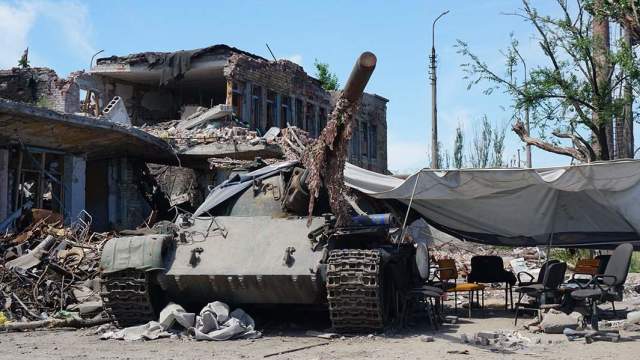
Photo: IZVESTIA/Alexey Ramm
Image source: iz.ru
Gradually, Russian and Donetsk assault units were able to enter the territory of Azovstal. Their main direction of attack was the converter shop near the seashore.
At first glance, it may seem that the Allied forces acted rudely and straightforwardly. They inflicted fire damage and moved forward under the cover of artillery fire and air strikes. In fact, the command identified vulnerable points of the Ukrainian defense and systematically put pressure on them. And this strategy has brought results.
Bunkers and ruins
We are driving along a serpentine road that leads to the converter shop. It starts from the bridge where the Ukrainian militants surrendered, goes down and leads us to the workshops and the famous "mountains" from the mining. On the way we meet a monument — the first Soviet all-wheel drive military all-terrain vehicle GAZ-69. Externally, the Gazik looks good. But upon closer examination, it becomes clear that his fights were not spared. There are holes from shrapnel and bullets all over the body of the car.
Converter production is actually a factory within a factory, a group of complex and high—tech industrial facilities and the infrastructure serving them. Now there is little left of these workshops — only a hodgepodge of destroyed buildings, fallen metal structures and broken equipment. It is necessary to move everywhere very carefully. Ammunition and booby traps are scattered on the ground, which were "kindly" left behind by Ukrainian militants. The wind blows and the neighborhood is filled with strange and sometimes frightening sounds. This air passes through the destroyed structures and creates its own symphonies of chaos.
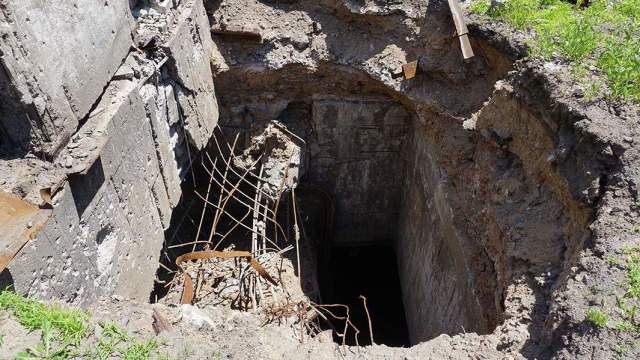
Photo: IZVESTIA/Alexey Ramm
Image source: iz.ru
At some point I have a strong feeling that I am in the computer game Death Stranding. The objects around me are very similar to the plot of the game. And it seems that rain is about to start and black ghosts will appear from the depths of these ruins, who will want to drag you to the next world. I have been to many places of fighting, repeatedly visited Mariupol when there were fighting clashes. But this place has its own unique dark aura.
There is a characteristic smell around — this is how the bodies of the dead smell. It was in the converter shops that there were several bunkers where Ukrainian militants were hiding. Here the most desperate defended themselves — the fighters of "Azov". Their task was to protect the mountains from mining.
Despite popular opinion, there was no underground city under Azovstal. Concrete protected bunkers were located under the workshops, but they are not interconnected. Therefore, food and ammunition were quickly running out there. And in order to get food and replenish ammunition, the militants had to leave their underground "holes" on the street and run to the storage bunkers.
The Allied command immediately realized that such rat trails between residential bunkers and underground storage facilities were the most vulnerable point of Azovstal's defense. Therefore, at the first stage, continuous artillery and air strikes were carried out on the territory of the plant. They isolated the militants in their dungeons and did not allow them to move around the territory of the plant. Later, heavy weapons systems — long-range Tu-22M3 bombers with three-ton bombs on board and super-heavy 2C4 "Tulip" mortars began to work. They have already knocked out underground storages and warehouses.
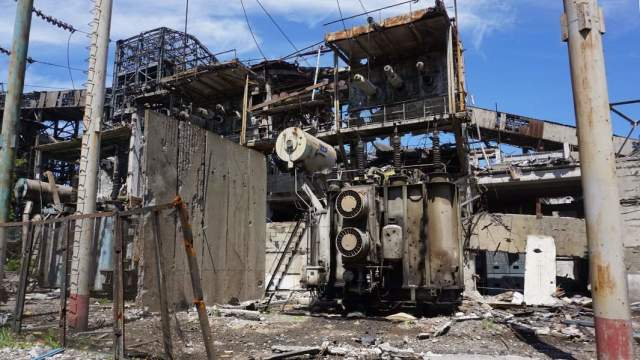
Photo: IZVESTIA/Alexey Ramm
Image source: iz.ru
There is a funnel between one of the converter shops and the railway track. Judging by its shape and size, it was a three-ton aerial bomb dropped from the Russian "carcass". The first ammunition did not reach the target a little. A huge pit was formed at the place of his fall. You can safely hide one or two Kamaz trucks in it. But the second bomb hit the target exactly. It went through the ground, destroyed the floors and destroyed the underground bunker. I'm standing at the edge of a small cliff. At the bottom I see destroyed concrete blocks and a punched hole. Judging by the sour smell, the Ukrainian militants who were holed up there were very unlucky.
But artillery and air strikes could not completely isolate the APU in their shelters. To establish control over the plant, it was necessary to take man-made slag heaps. The fire means placed on their top would surely hit the entire territory of Azovstal.
The marines of the Armed Forces of the Russian Federation and the forces of the DPR went to storm the mountains. It was a tough fight. Assault detachments landed on boats from the sea and fought their way along narrow paths to the peaks. They were opposed not by ordinary National guardsmen and marines, but by Azov militants. But despite fierce resistance, the Allied forces knocked out the enemy and took control of the mountains. From that moment on, the Ukrainian militants had no chance of salvation. A few days later, they requested negotiations and agreed to surrender.
Bunker rats
We descend into one of the surviving bunkers on the territory of the converter production. Not far from the entrance there are still two bodies of Ukrainian militants. Apparently they were carrying some supplies. But they did not manage to reach it. Now they are waiting for their turn to be buried. But it is still dangerous to approach their bodies.
The Azov militants were in the shelter where we were going. It was they who were supposed to hold the defense of the slag mountains. But they did not cope with their task. Their bunker is a solid room built together with the plant. Inside there is a generator and ventilation unit, which ensured the operation of production in peacetime. All entrances to the rooms in the bunker are covered with heavy blast doors with complex locks.
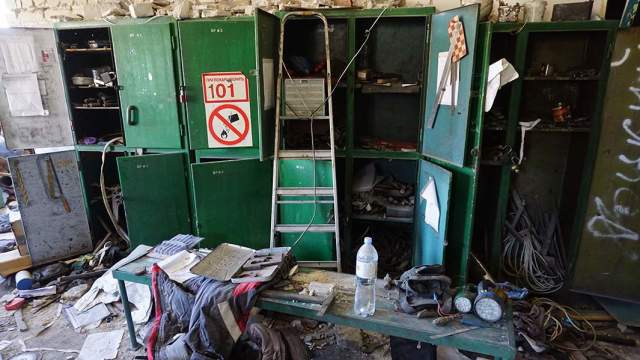
Photo: IZVESTIA/Alexey Ramm
Image source: iz.ru
Inside there are solid three-tiered bunks. They were clearly built long before the beginning of the SVO. Ukrainian militants carefully thought out their way of life. So, instead of mattresses, special plastic is laid out on the bunks. Everywhere there are bedside tables and cabinets for personal belongings, property and weapons. There are rooms where an improvised dining room is equipped. Small storerooms and ammunition storage areas. We find board games and fiction.
Surprisingly, the "Azov" massively removed their field uniforms. Instead, they wore the jacket of factory workers. There are hundreds of pieces of factory clothes lying around in the bunker. It is clearly visible that it was worn and used in battles. So, one of the victims is dressed in a red and black park with the inscription "Azovstal". And at first it seems that this is a factory worker. But on closer inspection, it is clearly visible that under the jacket of the deceased is a plain mustard—brown uniform of the National Guard of Ukraine. And the elements of equipment and good-quality LOWA combat boots confirm that we are not a peaceful hard worker. However, for some reason, the deceased really hoped that he would be mistaken for a simple worker.
The "Azovites" could not withstand the struggle with the Russian and Donetsk armed forces. On one of the beds we find a kind of diary. Apparently, the militant wrote it on plastic and the words were pushed under pressure. Although it is possible that the owner of the diary just decided to write it on plastic. In his memoirs, "Azovets" describes what losses his unit is suffering. How their morale is falling, how ammunition and food are running out. And it is these records that show well how the self-confidence and even the arrogance of the "Azovites" in the battles fell off. And how it became clear to them that there would be no evacuation.
Alexey Ramm
